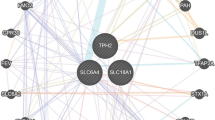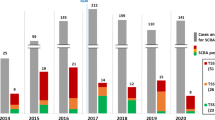Abstract
Introduction
Synthetic Cannabinoid Receptor Agonists (SCRAs) are the largest group of new psychoactive substances reported to the European Warning System and the United Nations Office on Drugs and Crime to date. The heterogeneous nature and speed of diversification of these compounds make it challenging to accurately characterise and predict harms of these compounds in pre-clinical studies, ahead of their appearance.
Case Report
We report the case of a 19-year-old female who purchased three products from a headshop: two new psychoactive substances (sachets of “cannabis tea” and “mushroom tea”) as well as two LSD blotters. After the “cannabis tea” was smoked and the two LSD blotters and “mushroom tea” were ingested, the patient became tachycardic (HR 128), developed seizures, agitation, visual hallucinations as well as suspected serotonergic toxicity (sustained ankle clonus 20–30 beats) 1–2 hours after use. She was treated with 1 mg of intravenous midazolam. Symptoms/signs resolved within 13 hours. No further supportive care was required. Plasma, blood, and urine samples confirmed the presence of two SCRAs: 5FAKB-48 and 5F-PB-22. The patient also reported therapeutic use of both fluoxetine and citalopram for depression.
Discussion
To the best of our knowledge, this is the first case report of non-fatal intoxication with 5F-AKB-48 with analytical confirmation and exposure times. It also highlights the difficulties in understanding the pattern of toxicity of certain SCRAs in the context of psychotropic medications/co-morbid mental illness.


Similar content being viewed by others
References
EMCDDA. European Drug Report (Trends and Developments). 2015. http://www.emcdda.europa.eu/edr2015. Accessed: 15 Nov 2015.
Mechoulam R, Gaoni Y. A total synthesis of D1-delta-1-tetrahydrocannabinol, the active constituent of hashish. J Am Chem Soc. 1965;87:3273–5.
Wagner JA, Jarai Z, Batkai S, Kunos G. Hemodynamic effects of cannabinoids: coronary and cerebral vasodilation mediated by cannabinoid CB1 receptors. Eur J Pharmacol. 2001;423:203–10.
Calignano A, Katona I, Desarnaud F, Giuffrida A, La Rana G, Mackie K, Freund TF, Piomelli D. Bidirectional control of airway responsiveness by endogenous cannabinoids. Nature. 2000;408:96–101.
De Petrocellis L, Melck D, Bisogno T, Di Marzo V. Endocannabinoids and fatty acid amides in cancer, inflammation and related disorders. Chem Phys Lipids. 2000;108:191–209.
Wilson RI, Nicoll RA. Endocannabinoid signaling in the brain. Science. 2002;296:678–82.
Tomida I, Pertwee RG, Azuara-Blanco A. Cannabinoids and glaucoma. Br J Ophthalmol. 2004;88:708–13.
Maccarrone M. CB2 receptors in reproduction. Br J Pharmacol. 2008;153:189–98.
Le Foll B, Goldberg SR. Cannabinoid CB1 receptor antagonists as promising new medications for drug dependence. JPET. 2005;312:875–83.
Cota D, Marsicano G, Lutz B, Vicennati V, Stalla GK, Pasquali R, Pagotto U. Endogenous cannabinoid system as a modulator of food intake. Int J Obes. 2003;27:289–301.
Janero DR, Makriyannis A. Cannabinoid receptor antagonists: pharmacological opportunities, clinical experience, and translational prognosis. Expert Opin Emerg Drugs. 2009;14:43–65.
Devane WA, Dysarz 3rd FA, Johnson MR, Melvin LS, Howlett AC. Determination and characterization of a cannabinoid receptor in rat brain. Mol Pharmacol. 1988;34:605–13.
Matsuda LA, Lolait SJ, Brownstein MJ, Young AC, Bonner TI. Structure of a cannabinoid receptor and functional expression of the cloned cDNA. Nature. 1990;346:561–4.
Everett RM, Descotes G, Rollin M, Greener Y, Bradford JC, Benziger DP, Ward SJ. Nephrotoxicity of pravadoline maleate (WIN 48098-6) in dogs: evidence of maleic acid-induced acute tubular necrosis. Fundam Appl Toxicol. 1993;21:59–65.
Wiley JL, Marusich JA, Huffman JW, Balster RL, Thomas BF. Hijacking of basic research: the case of synthetic cannabinoids. Methods Rep RTI Press. 2011;2011:17971.
EMCDDA. Perspectives on drugs. Synthetic cannabinoids in Europe. 2015. http://www.emcdda.europa.eu/attachements.cfm/att_212361_EN_Synthetic%20cannabinoids_updated2015.pdf. Accessed 22 Dec 2015.
Karila L, Roux P, Rolland B, Benyamina A, Reynaud M, Aubin HJ, Lançon C. Acute and long-term effects of cannabis use: a review. Curr Pharm Des. 2014;20:4112–8.
Schneir AB, Cullen J, Ly BT. “Spice” girls: synthetic cannabinoid intoxication. J Emerg Med. 2011;40:296–9.
Tait RJ, Caldicott D, Mountain D, Hill SL, Lenton S. A systematic review of adverse events arising from the use of synthetic cannabinoids and their associated treatment. Clin Toxicol (Phila). 2015;15:1–13.
Lovett C, Wood DM, Dargan PI. Pharmacology and toxicology of the synthetic cannabinoid receptor agonists. Réanimation. 2015;24:527–41.
EMCDDA–Europol joint publication. EMCDDA–Europol 2014 Annual Report on the implementation of Council Decision 2005/387/JHA. 2014. http://www.emcdda.europa.eu/attachements.cfm/att_240380_EN_TDAN15001ENN.pdf. Accessed 22 Nov 2015.
United Nations Office on Drugs and Crime. Global synthetic drugs assessment amphetamine-type stimulants and new psychoactive substances. 2014. https://www.unodc.org/documents/scientific/2014_Global_Synthetic_Drugs_Assessment_web.pdf. Accessed 22 Dec 2015.
De Luca MA, Castelli MP, Loi B, Porcu A, Martorelli M, Miliano C, Kellett K, Davidson C, Stair LJ, Schifano F, Di Chiara G. Native CB1 receptor affinity, intrinsic activity and accumbens shell dopamine stimulant properties of third generation SPICE/K2 cannabinoids: BB-22, 5F-PB-22, 5F-AKB-48 and STS-135. Neuropharmacology. 2015;11.
BlueLight. AKB-48-F Experience report. http://www.bluelight.org/vb/threads/647964-AKB-48-F-Experience-report. Accessed 15 Nov 2015.
BlueLight. 627774-Cannabinoid-AKB-48. http://www.bluelight.org/vb/threads/627774-Cannabinoid-AKB-48. Accessed 15 Nov 2015.
Drugs-Forum. Experiences - 5F-AKB48, BB-22, 5F-PB22, STS-135 Last Gen Noids comparison from experience. https://drugs-forum.com/forum/showthread.php?t=226101. Accessed 15 Nov 2015.
Gurney SMR, Scott KS, Kacinko SL, Presley BC, Logan BK. Pharmacology, toxicology, and adverse effects of synthetic cannabinoid drugs. Forensic Sci Rev. 2014;26:53–78.
Banister SD, Stuart J, Kevin RC, Edington A, Longworth M, Wilkinson SM, Beinat C, Buchanan AS, Hibbs DE, Glass M, Connor M, McGregor IS, Kassiou M. Effects of Bioisosteric fluorine in synthetic cannabinoid designer drugs JWH-018, AM-2201, UR-144, XLR-11, PB-22, 5F-PB-22, APICA, and STS-135. ACS Chem Neurosci. 2015;6:1445–58.
Gatch MB, Forster MJ. Δ9-tetrahydrocannabinol-like effects of novel synthetic cannabinoids found on the gray market. Behav Pharmacol. 2015;26:460–8.
Trecki J, Gerona RR, Schwartz MD. Synthetic cannabinoid–related illnesses and deaths. (perspective). N Engl J Med. 2015;373:2.
Schep LJ, Slaughter RJ, Hudson S, Place R, Watts M. Delayed seizure-like activity following analytically confirmed use of previously unreported synthetic cannabinoid analogues. Hum Exp Toxicol. 2015;34:557–60.
Gugelmann H, Gerona R, Li C, Tsutaoka B, Olson KR, Lung D. ‘Crazy monkey’ poisons man and dog: human and canine seizures due to PB-22, a novel synthetic cannabinoid. Clin Toxicol (Phila). 2014;52:635–8.
Hussain F, Al-musawi H, Al-khateeb E, Abu sayf A. Ischemic cerebrovasular accident, uncontrolled seizuresand acute myocardial infarction associated with syn thetic marijuana abuse. Am J Intern Med. 2014;2:138–14.
Hermanns-Clausen M, Kneisel S, Szabo B, Auwärter V. Acute toxicity due to the confirmed consumption of synthetic cannabinoids: clinical and laboratory findings. Addiction. 2013;108:534–44.
Behonick G, Shanks KG, Firchau DJ, Mathur G, Lynch CF, Nashelsky M, Jaskierny DJ, Meroueh C. Four postmortem case reports with quantitative detection of the synthetic cannabinoid, 5F-PB-22. J Anal Toxicol. 2014;38:559–62.
Author information
Authors and Affiliations
Corresponding author
Ethics declarations
Conflict of Interest
Authors Rachelle Abouchedid, James H. Ho, Simon Hudson, Alison Dines, John RH. Archer, David M. Wood and Paul I. Dargan declare that they have no conflict of interest.
Professor Dargan reports that he is a member of the UK Advisory Council on the Misuse of Drugs and the Scientific Committee of the European Monitoring Centre for Drugs and Drug Addiction.
Sources of Funding
None
Informed Consent
Consent for publication of this case was obtained and provided to the journal in accordance with JMT policy.
Rights and permissions
About this article
Cite this article
Abouchedid, R., Ho, J.H., Hudson, S. et al. Acute Toxicity Associated with Use of 5F-Derivations of Synthetic Cannabinoid Receptor Agonists with Analytical Confirmation. J. Med. Toxicol. 12, 396–401 (2016). https://doi.org/10.1007/s13181-016-0571-7
Received:
Revised:
Accepted:
Published:
Issue Date:
DOI: https://doi.org/10.1007/s13181-016-0571-7




